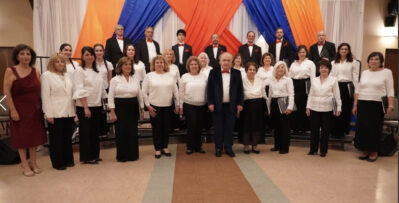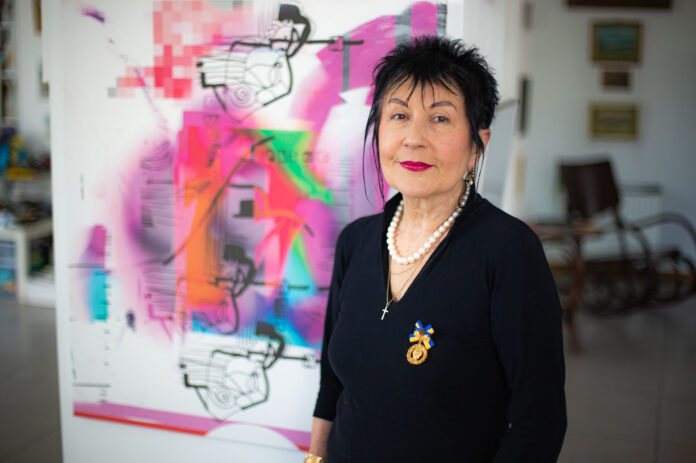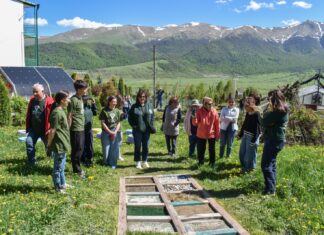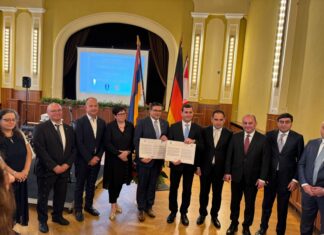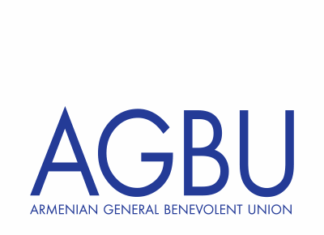YEREVAN/ODESA — Karmella Tsepkolenko (b. 1955, Odesa) is a renowned Ukrainian composer, laureate of the Taras Shevchenko National Prize of Ukraine (2024), recipient of the B. N. Lyatoshynsky Prize (2001), educator, professor (since 2009), with a PhD in pedagogy, secretary of the Board of the National Union of Composers of Ukraine, and an Honored Artist of Ukraine. From 1962 to 1973, she studied at the Odesa Special Secondary Music School. She continued her musical education at the Odesa Conservatory (1973–1979), where she studied composition and piano. From 1986 to 1989, she pursued postgraduate studies at the Moscow Pedagogical Institute. She also attended composition masterclasses in Germany three times.
Since 1980, she has been teaching composition at the Odesa V. Nezhdanova State Music Academy. In her teaching, she employs her original method, “Scenario-Based Development of Musical Material.” She has led masterclasses at institutions in Germany, Moldova, Russia, Switzerland, and the USA. Tsepkolenko is a participant in numerous international festivals and forums and a laureate of international composition competitions.
In 1995, she initiated and became the artistic director of the annual festival Two Days and Two Nights of New Music in Odesa — an event featuring contemporary music by Ukrainian and foreign composers, primarily of an experimental nature. She is also the founder and chair of the board of the international public organization Association New Music, which serves as the Ukrainian section of the International Society for Contemporary Music. She has established a school of contemporary composition in southern Ukraine and has trained many students — composers who have become laureates of national and international awards.
During the Russo-Ukrainian war, Karmella Tsepkolenko devised the slogan “Ukrainian women composers with their own weapon” as part of her creative wartime strategy and launched a project featuring works by composers and poets written during the war.
Dear Karmella, since 2022, whenever I speak with Ukrainians, I always begin with wishes for a swift peace — in Ukraine and throughout the world. Odesa, where you live, was recently bombed again by the Russian army. Nevertheless, you continue to hold the Two Days and Two Nights of New Music festival…
Dear Artsvi, just today (June 16, 2025), on one of the countless days of this terrible war, one of the most destructive attacks on Odesa and Kyiv took place. Entire blocks in the city center have been destroyed or damaged. The Russians are employing a scorched-earth tactic with absolute cynicism and cruelty. While Western and American politicians direct their efforts toward achieving a just and lasting peace in Ukraine, the aggressor continues to spread destruction and death. The Russian army has begun using very powerful drones carrying 150–200 kilograms of explosives, which are launched in swarms. We do not have enough capacity to shoot them all down. That is why there is such severe destruction and so many civilian casualties.
As for our annual international festival Two Days and Two Nights of New Music, it has been representing contemporary Ukrainian art in Odesa for decades, at a level comparable to the best global standards. During wartime, the festival has become a powerful artistic weapon in the fight against the Russian invaders. Its programs unite works by Ukrainian and foreign composers written during the war, reflecting — whether directly or allegorically — the heroism of the Ukrainian people, their armed forces, and the unprecedented support of Ukraine by Western countries.
The festival emerged in the early years of Ukraine’s independence and is almost the same age as the young Ukrainian state. Throughout its history, the festival’s efforts have been aimed at developing contemporary academic music: more than 2,700 performances of approximately 2,500 different works by 1,264 Ukrainian and foreign composers have taken place. Thousands of Ukrainian and foreign composers and performers have participated in the festival over the years.
Since its founding, only in 2022 — due to the start of the full-scale war — was it impossible to hold the 28th festival, which then took place in 2023. Despite the ongoing war, the 29th festival was successfully held in 2024, and the 30th edition is planned for August 2025 as a major cultural event, aimed at demonstrating to the world that Ukrainian culture is indomitable and continues to exist and develop even under the extraordinary conditions of war.
In May of this year, during the Yerevan contemporary music festival Crossroads 2025, we heard your compositions. In one of them, I thought I heard notes of alarm linked to the war. Was I right?
In the cantata Woher, schwarzer Tross, fliehender Schwarm, kommst du geflogen? (“Where Are You From, Black Rolling Flock of Birds?”) for soprano, mezzo-soprano, tenor, and baritone, set to the poetry of Serhiy Zhadan, there are indeed imitations of bomb explosions, air raid sirens, and machine gun bursts. This cantata was composed in May 2022 in Odesa on commission from association maezenatentum.at for the renowned Austrian ensemble REIHE Zykan +, with financial support from Federal Ministry for Housing, Arts, Culture, Media and Sport of Austria. The text was translated into German by Claudia Dathe for the German publishing house Suhrkamp Verlag. In developing the piece dramatically, I used game-based compositional techniques and intensified the dramatization by incorporating a sense of competition between the vocal parts. At climactic moments, the texture becomes rich with polylinear, multilayered, meaning-forming structures. Dialogic imagery, opposition and fusion, internal and external conflict — all shape a sequential dramatic arc that resolves entirely in an emotional outburst. Special attention was given to the phenomenon of time: by densifying the event load per time unit and using methods of virtual inversions and bidirectional time flow, I aimed to evoke a sensation of compressed subjective time.
This was your fourth visit to Armenia. Could you tell us about your earlier visits and your connections with Armenian musicians?
My first trip was in 1978, to participate in the All-Union Festival of Creative Universities. It was unforgettable! We spent a week and a half in Yerevan, attending many fascinating concerts, meetings, and trips to Garni, Geghard, Sevan, and Zvartnots. I received my first diploma there for my piano piece Variations. I had the honor of meeting giants of Armenian music such as Edvard Mirzoyan and Alexander Arutyunyan.
My second visit was in 1982, when the Odesa branch of the Union of Composers of the USSR visited Armenia for an exchange program between the republican organizations. It was equally memorable. We gave concerts in Dilijan, Yerevan and Sardarapat. We also visited Echmiadzin, where we were allowed to descend into the cellar and see the ancient pagan site upon which the cathedral was built.
The third trip was in 2019, for a field session of the Music Olymp international competition for young musicians in Vanadzor, where I was on the jury. Yerevan amazed me with its scale—forty years had passed since my previous visit. A cooperation agreement was signed between the Kyiv and Odesa academies and the Yerevan Komitas Conservatory, but unfortunately, the wars prevented its realization.

The fourth visit: 2025, at the Crossroads 2025 international festival, invited by the QuarterTone NGO. Aside from my participation in the festival, a seminar was held dedicated to my work, showcasing key compositions. Two works were performed in concert, one of them commissioned by QuarterTone specifically for the festival, and I conducted a masterclass with students of the Yerevan Conservatory. The commissioned piece, Collisions for flute, clarinet, piano, violin, viola, and cello, was also inspired by the war. I sought to reflect the clash between peaceful life and war, a multi-dimensional confrontation of opposing values, mindsets, life rhythms, behaviors — even perceptions of time and space. It was performed by the ensemble Assonance, to whom I am very grateful for their inspired and technically superb interpretation. The second piece, Im Träumen… und hier unten auf der Erde (“In Dreams… and Here Below on Earth”) for flute, cello, and piano, was also beautifully performed by Assonance within the same project. It contrasts two parts: the first is melancholic, monotonous, and cloud-like; the second is active and restless, striving for perfection.
Every visit to Armenia leaves a deep impression. Each time brings new experiences — and something indescribable that stirs deep in the soul — something that connects you with past generations.
Many Armenian musicians came to Odesa through the Cultural Connections program funded by the Open Society Institute. The Armenian side was coordinated by you, Artsvi, and the Odesa side by myself and my husband, musicologist Alexander Perepelitsa. These were diverse projects involving composers, performers, dancers, and theater artists. Armenian musicians have also participated in our Two Days and Two Nights of New Music festival — Edward Ayrapetyan, Vache Sharafyan, Robert Amirkhanyan, Trio Shell, Suren and Gayane Hahnazaryans, Tsovinar Movsisyan, Gevorg Dabaghyan, Mikhail Kokzhaev, among others. Another major initiative was the Traveling Academy of Music, organized by the Odesa branch of the Open Society Institute (“Vidrodzhennia”), in which Armenian performers also took part.
You have not only creative but also family ties to Armenia. I met your husband in 1998, and he mentioned that you are Armenian on your mother’s side.
My maternal grandfather, Kevork Kasparovich Demurchian, was born in 1881 in the autonomous community of Khotorjur in the Erzurum vilayet of Western Armenia. Khotorjur, consisting of two village clusters, was mostly populated by Catholic Armenians and was sometimes called “Little Rome.” In the early 1900s, Kevork, the son of a prosperous merchant, went to study at the Kyiv Commercial School in the Russian Empire. After graduating, he returned home, married Elbis Apozian (from a priest’s family), and in 1912 moved to Russia again with his wife and daughter to start a business. He settled in Nikolaev, where he bought a mill, several bakeries, and confectioneries. My mother, Mariam Kevorkovna Demurchian, was born in Nikolaev in 1914. Just a few months later, the genocide of 1915 began in Khotorjur.
My grandfather played the flute and mandolin well. Family concerts were common at home. His eldest daughter Siranush (Lyuba) played the piano, his son Kaspar the violin, and my mother danced. From a young age, my mother studied with governesses—languages (German, French), piano, and drawing. She also trained in classical ballet. In 1928, when the Bolshoi Theatre came to Nikolaev to stage Reinhold Glière’s Red Poppy, my mother was selected to perform as one of the Chinese girls. Choreographer Alexander Shiryaev invited her to study in Moscow, but then fate turned. Tragedy struck our family. My grandmother died in childbirth. The four children — Siranush, Mariam, Oghida (Olga) and Kaspar — were left alone. Grandfather was arrested as an “enemy of the people.” The children moved to Kyiv to live with their relative Vartan, a high-ranking party official (later imprisoned for alleged Dashnak affiliations).
My mother, a talented draughtswoman, found work in a design office. During the war, she served as a translator at headquarters, speaking fluent German, and reached Berlin with the troops. Olga finished medical school under occupation and later served on the front as a doctor. Kaspar also fought and returned as a captain, later working in KyivEnergo and organizing an amateur orchestra where he played and conducted. After the war, my mother, Olga, and my grandfather moved to Odesa. My mother married Semen Dmitrievich Tsepkolenko — my father.
Were any Armenian traditions preserved in your family — musical, culinary, or otherwise?
Since my grandfather and Vartan lived with us, they spoke Armenian with my mother. Sadly, I never learned Armenian, likely because Russian dominated all spheres at the time. I deeply regret not immersing myself in the language. Grandfather baked Easter cakes using old recipes (this skill saved him during the repressions—he worked as a baker in the camps). From Armenian cuisine, my mother made tolma, tanabur (yoghurt soup), ghavurma, gata and shakar lokhum.
You are the author of over 100 works for orchestra, chamber ensembles, vocal, piano, organ, three operas, and more. Do any of them relate to Armenia?
Yes, the Requiem Symphony, composed in 1988, which became a form of artistic reflection on both tragic and heroic historic events. It was inspired by two cornerstones of Armenian memory: the Genocide and the Battle of Sardarapat. I mentioned my visit to Sardarapat in 1982, which left a profound impact. Sardarapat became a symbol of victory that later inspired me artistically. Six years after that visit, I began composing the symphony. The memory of the Sardarapat battle crystallized into a musical scenario. The music unfolded naturally, reflecting my inner emotional world. The theme of the Armenian Genocide was not just a historical fact to me — it was personal. My maternal ancestors’ place, Khotorjur, was central to both massacres and resistance (I have a book with a photo of my grandfather in uniform as a defender). Many of his relatives perished during the genocide. One of the few survivors among the 35,000 residents was our relative, the Armenian poet François Bortchalyan, who later returned from France to Armenia and became a monk in Echmiadzin.
Thank you for your heartfelt responses, dear Karmella. I hope you will return once again to your mother’s homeland — this time with new compositions. And may peace soon be restored in Ukraine and throughout the world.
